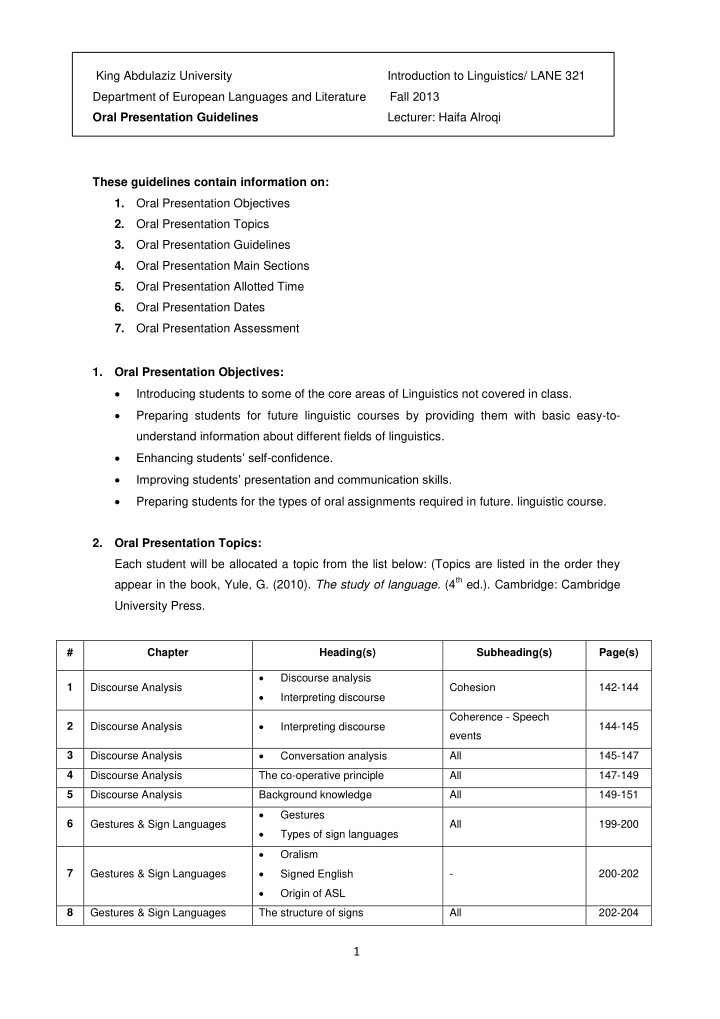



King Abdulaziz University Introduction to Linguistics/ LANE 321 Department of European Languages and Literature Fall 3102 Oral Presentation Guidelines Lecturer: Haifa Alroqi These guidelines contain information on: 1. Oral Presentation Objectives 2. Oral Presentation Topics 3. Oral Presentation Guidelines 4. Oral Presentation Main Sections 5. Oral Presentation Allotted Time 6. Oral Presentation Dates 7. Oral Presentation Assessment 1. Oral Presentation Objectives: Introducing students to some of the core areas of Linguistics not covered in class. Preparing students for future linguistic courses by providing them with basic easy-to- understand information about different fields of linguistics. Enhancing students’ self -confidence. Improving students’ presentation and communication skills. Preparing students for the types of oral assignments required in future. linguistic course. 2. Oral Presentation Topics: Each student will be allocated a topic from the list below: (Topics are listed in the order they appear in the book, Yule, G. (2010). The study of language . (4 th ed.). Cambridge: Cambridge University Press. # Chapter Heading(s) Subheading(s) Page(s) Discourse analysis 1 Discourse Analysis Cohesion 142-144 Interpreting discourse Coherence - Speech 2 Discourse Analysis 144-145 Interpreting discourse events 3 Discourse Analysis Conversation analysis All 145-147 4 Discourse Analysis The co-operative principle All 147-149 5 Discourse Analysis Background knowledge All 149-151 Gestures 6 Gestures & Sign Languages All 199-200 Types of sign languages Oralism 7 Gestures & Sign Languages Signed English - 200-202 Origin of ASL 8 Gestures & Sign Languages The structure of signs All 202-204 1
The meaning of signs 9 Gestures & Sign Languages Representing signs - 204-207 ASL as a natural language 10 Language History & Change Family trees All 225-226 11 Language History & Change Comparative reconstruction All 227-228 Old English – Middle 12 Language History & Change The history English 228-230 English Sound changes - 13 Language History & Change The history English 231-233 Syntactic changes The history English 14 Language History & Change Semantic changes 233-234 Diachronic and synchronic variation The standard language 15 Language & Regional Variation - 240-241 Accent and dialect 16 Language & Regional Variation Dialectology Regional dialects 241-242 Isoglosses and dialect boundaries – The dialect 17 Language & Regional Variation Dialectology 242-244 continuum Bilingualism and diaglossia 18 Language & Regional Variation - 244-247 Language planning Pidgins and creoles 19 Language & Regional Variation - 247-249 The post-creole continuum 20 Language & Social Variation Sociolinguistics Social dialects 254-255 Education and occupation 21 Language & Social Variation Sociolinguistics 255-256 - Social markers 22 Language & Social Variation Speech style and style-shifting Prestige 257-258 Speech accommodation – 23 Language & Social Variation Speech style and style-shifting Register and jargon - 258-260 Slang 24 Language & Social Variation African American English All 260-262 Culture 25 Language & Culture All 267-269 Categories 26 Language & Culture Linguistic relativity All 269-271 27 Language & Culture Cognitive categories All 271-272 28 Language & Culture Social categories All 272-274 29 Language & Culture Gender Gendered words 274-275 Gendered speech- 30 Language & Culture Gender 275-277 Gendered interaction 2
3. Oral Presentation Guidelines: Your presentation should be an explanation of the assigned part. Your presentation should be saved in a CD not a USB Flash Drive. USB Flash Drives might take a long time to be configured by computers and have a high risk of viruses! Please check with your instructor in advance to ensure the compatibility of the format you are using for your presentation with the device/ computer used to show your presentation. You must send a soft copy of your presentation to your in structor’s email address , lane321@outlook.com You must hand in a handout of your presentation to your instructor prior to giving your presentation. If you need extra equipments (e.g. speakers), please arrange with your instructor in advance. 4. Oral Presentation Main Sections: Your presentation must include the following: The first slide should have: - The Name of the institution (i.e. Department of European Languages and Literature, Faculty of Arts and Humanities, King Abdulaziz University) - The Course Title and Code (i.e. Introduction to Linguistics - LANE 321) - The title of your presentation (Choose a suitable title) - Your name/ Student ID - Your instructor's name (i.e. Lecturer Haifa Alroqi) - The academic semester (i.e. Fall 2013) - The date of your presentation Introductory slide(s): Outline of the Presentation Body slides Concluding slide(s): Main Points of the Presentation References: Written according to the APA Referencing Style A “ Thank you ” slide 5. Oral Presentation Allotted Time: Each Oral Presentation will be allocated a five-minute slot. Presenters are expected to strictly adhere to the time limit. 6. Oral Presentation Dates: Please refer to the instructor’s webpage, halroqi.kau.edu.sa > English > Fall 2013 > Oral Presentation Schedule > Your Section (DAR or GAR) 7. Oral Presentation Assessment: - Your Oral Presentation is worth 10% of your total course grade. - The Oral Presentation will be evaluated and graded using the Oral Presentation Rubric . 3
Recommend
More recommend